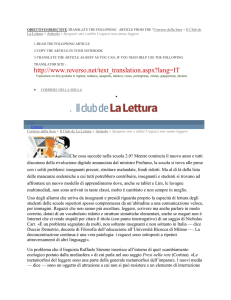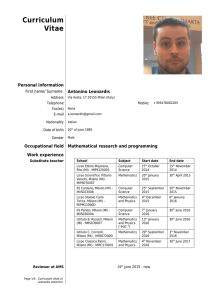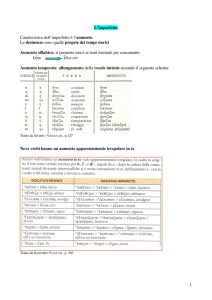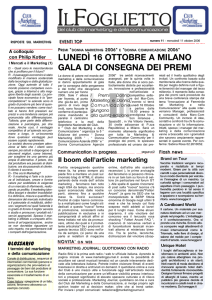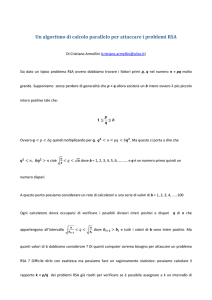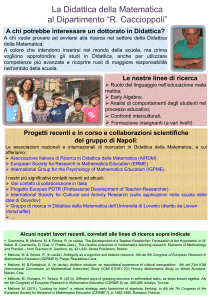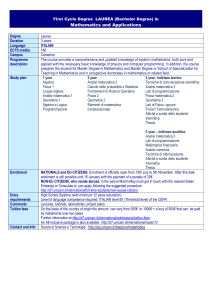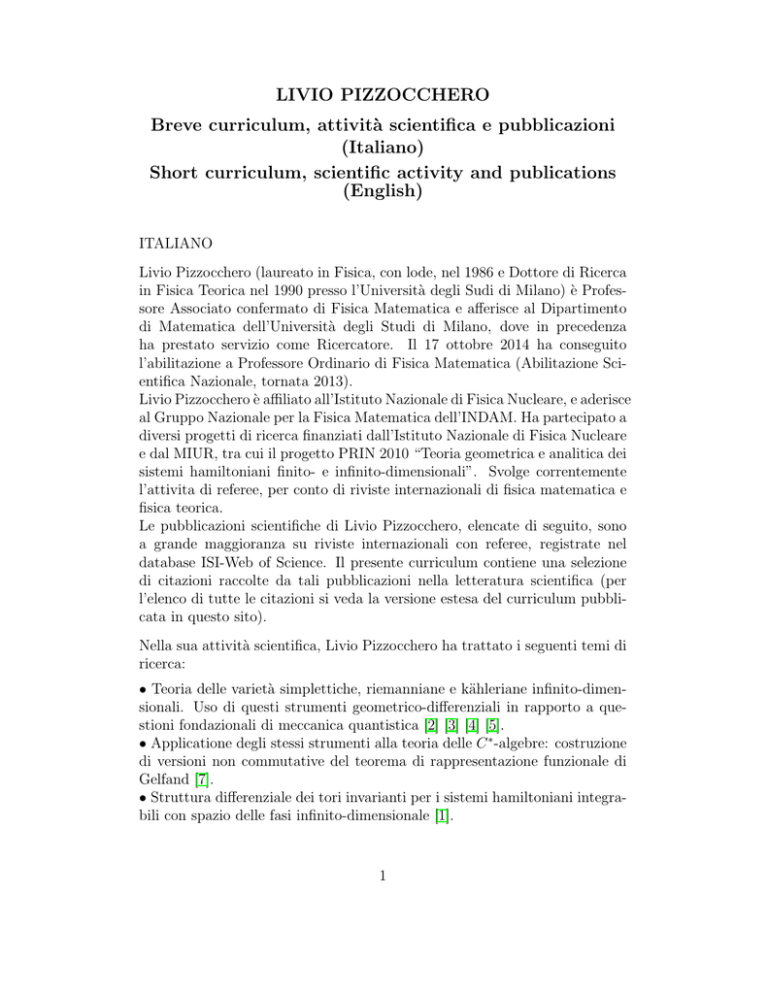
LIVIO PIZZOCCHERO
Breve curriculum, attività scientifica e pubblicazioni
(Italiano)
Short curriculum, scientific activity and publications
(English)
ITALIANO
Livio Pizzocchero (laureato in Fisica, con lode, nel 1986 e Dottore di Ricerca
in Fisica Teorica nel 1990 presso l’Università degli Sudi di Milano) è Professore Associato confermato di Fisica Matematica e afferisce al Dipartimento
di Matematica dell’Università degli Studi di Milano, dove in precedenza
ha prestato servizio come Ricercatore. Il 17 ottobre 2014 ha conseguito
l’abilitazione a Professore Ordinario di Fisica Matematica (Abilitazione Scientifica Nazionale, tornata 2013).
Livio Pizzocchero è affiliato all’Istituto Nazionale di Fisica Nucleare, e aderisce
al Gruppo Nazionale per la Fisica Matematica dell’INDAM. Ha partecipato a
diversi progetti di ricerca finanziati dall’Istituto Nazionale di Fisica Nucleare
e dal MIUR, tra cui il progetto PRIN 2010 “Teoria geometrica e analitica dei
sistemi hamiltoniani finito- e infinito-dimensionali”. Svolge correntemente
l’attivita di referee, per conto di riviste internazionali di fisica matematica e
fisica teorica.
Le pubblicazioni scientifiche di Livio Pizzocchero, elencate di seguito, sono
a grande maggioranza su riviste internazionali con referee, registrate nel
database ISI-Web of Science. Il presente curriculum contiene una selezione
di citazioni raccolte da tali pubblicazioni nella letteratura scientifica (per
l’elenco di tutte le citazioni si veda la versione estesa del curriculum pubblicata in questo sito).
Nella sua attività scientifica, Livio Pizzocchero ha trattato i seguenti temi di
ricerca:
• Teoria delle varietà simplettiche, riemanniane e kähleriane infinito-dimensionali. Uso di questi strumenti geometrico-differenziali in rapporto a questioni fondazionali di meccanica quantistica [2] [3] [4] [5].
• Applicatione degli stessi strumenti alla teoria delle C ∗ -algebre: costruzione
di versioni non commutative del teorema di rappresentazione funzionale di
Gelfand [7].
• Struttura differenziale dei tori invarianti per i sistemi hamiltoniani integrabili con spazio delle fasi infinito-dimensionale [1].
1
• Strutture geometriche ed algebriche fondamentali nella teoria dei sistemi
integrabili: formalismo di Lax e bi-hamiltoniano, teoria della matrice R.
Applicazioni alle equazioni solitoniche, ai reticoli di tipo Toda e alla teoria
del corpo rigido multidimensionale [10] [12] [13] [14] [15] [16] [24] [25].
• Supersimmetrizzazione delle equazioni solitoniche; aspetti generali della
teoria dei sistemi integrabili su supervarietà [6] [8] [9] [11] [20].
• Studi di storia della matematica: la geometria differenziale in Italia, con
particolare riferimento al periodo tra le due guerre mondiali [17].
• Metodi di approssimazione per funzioni speciali [22].
• Aspetti deterministici e stocastici nei processi con nucleazione e crescita di
grani [28] [30].
• Risultati di esistenza su tempi lunghi e stima dell’errore del metodo della
media per sistemi integrabili finito-dimensionali perturbati. Applicazioni al
moto dei satelliti [27] [31] [32].
• Spazi di Sobolev: disuguaglianze di immersione, stime alla Nash-Moser sul
prodotto puntuale di funzioni e sugli operatori nonlineari di composizione
con una funzione data (operatori di Nemytskij). Stime sulle migliori costanti
in alcune di queste disuguaglianze [18] [19] [21] [26] [36] [38] [46] [49].
• Equazioni di evoluzione semi- o quasi- lineari in spazi di Banach; stime
sull’intervallo di esistenza e proprietà di regolarità delle soluzioni esatte, deducibili dall’analisi “ a posteriori” di soluzioni approssimate [23] [29].
• Applicazioni dello schema precedente alle equazioni di Eulero o NavierStokes; condizioni di esistenza e regolarità locale o globale per le soluzioni
[34] [37] [39] [40] [41] [43].
• Approccio rigoroso alla rinormalizzazione in teoria quantistica dei campi:
applicazioni all’effetto Casimir [35] [47] [48] [44] [45].
2
ENGLISH
Livio Pizzocchero (degree in Physics, summa cum laude, in 1986 and PhD in
Theoretical Physics in 1990 at the University of Milano) is currently Associate
Professor of Mathematical Physics in the Department of Mathematics of
the Università degli Studi di Milano; on October 17, 2014 he obtained the
Italian national habilitation for a Full Professorship in Mathematical Physics
(Abilitazione Scientifica Nazionale, tornata 2013).
Livio Pizzocchero is affiliated to the Italian Istituto Nazionale di Fisica Nucleare and to the Italian Istituto Nazionale di Alta Matematica. He took part
in several research projects sponsored by the Istituto Nazionale di Fisica Nucleare and by the Italian Ministry of University, e.g. the MIUR, PRIN 2010
Research Project “Geometric and analytic theory of Hamiltonian systems in
finite and infinite dimensions”. He served as a referee for several international
journals in the areas mathematical physics or theoretical physics.
The scientific publications of Livio Pizzocchero are listed hereafter; most of
them are in international refereed journals recorded in the ISI-Web of Science
database. The present curriculum contains some selected citations of these
publications in the scientific literature (for the list of all citations, see the
extended version of the curriculum available on this web site).
The scientific activity of Livio Pizzocchero has dealt with the following subjects:
• Infinite-dimensional symplectic, Riemannian and Kählerian manifolds: general theory, and applications to quantum mechanics [2] [3] [4] [5].
• Applications of the same geometrical tools to the theory of C ∗ -algebras:
non commutative versions of Gelfand’s functional representation theorem [7].
• Integrable Hamiltonian systems with infinte-dimensional phase space, and
differential structures for their invariant tori [1].
• Basic algebraic and geometrical structures in the theory of integrable systems: Lax and biHamiltonian formalism, R-matrix theory. Applications to
soliton equations, to lattices of the Toda type and to the multidimensional
rigid body [10] [12] [13] [14] [15] [16] [24] [25].
• Supersymmetric soliton equations; general aspects in the theory of integrable systems on supermanifolds [6] [8] [9] [11] [20].
3
• History of Italian mathematics (especially, of differential geometry in the
period between the two World Wars) [17].
• Approximation techniques for special functions [22].
• Deterministic and stochastic models for crystal growth [28] [30].
• Existence results over long times and error estimates about the averaging
method for pertubations of finite-dimensional integrable systems. Applications to satellite motions [27] [31] [32].
• Sobolev spaces: imbedding inequalities, estimates of the Nash-Moser type
on pointwise multiplication and on the nonlinear operators of composition
with a given function (Nemytskij operators). Estimates on the best constants
in some of these inequalities [18] [19] [21] [26] [36] [38] [46] [49].
• Semi- or quasi-linear evolution equations in Banach spaces: estimates on
the interval of existence and regularity properties of exact solutions, derivable
from the “a posteriori analysis” of approximate solutions [23] [29].
• Applications of the previous framework to the Euler or Navier-Stokes equations; conditions for local or global existence and regularity of the solutions
[34] [37] [39] [40] [41] [42] [43].
• Rigorous approach to renormalization in quantum field theory; applications
to the Casimir effect [35] [47] [48] [44] [45].
4
LIVIO PIZZOCCHERO. PUBBLICAZIONI/PUBLICATIONS
ARTICLE:= link to the published article;
E-PRINT:= link to the arXiv e-print
[1] R. Cirelli, L. Pizzocchero, On the Integrability of Quantum Mechanics
as an Infinite-Dimensional Hamiltonian System, Nonlinearity 3, 10571080 (1990). ARTICLE
[2] R. Cirelli, A. Manià, L. Pizzocchero, Quantum Mechanics as an InfiniteDimensional Hamiltonian System with Uncertainty Structure. Part I, J.
Math. Phys. 31, 2891-2897 (1990). ARTICLE
[3] R. Cirelli, A. Manià, L. Pizzocchero, Quantum Mechanics as an InfiniteDimensional Hamiltonian System with Uncertainty Structure. Part II,
J. Math. Phys. 31, 2898-2903 (1990). ARTICLE
[4] L. Pizzocchero, La meccanica di Schrödinger nell’ approccio geometrico. Completa integrabilità, Tesi di dottorato, III Ciclo, Università
degli Studi di Milano (1990).
[5] R. Cirelli, A. Manià, L. Pizzocchero, Quantum Phase Space Formulation of Schrödinger Mechanics, Int. J. Mod. Phys. A 6, 2133-2146
(1991). ARTICLE
[6] C. Morosi, L. Pizzocchero, On the biHamiltonian Structure of the Supersymmetric KdV Hierarchies. A Lie Superalgebraic Approach, Commun. Math. Phys. 158, 267-288 (1993). ARTICLE
[7] R. Cirelli, A. Manià, L. Pizzocchero, A Functional Representation for
Non Commutative C ∗ -Algebras, Rev. Math. Phys. 6, 675-697 (1994).
ARTICLE
[8] C. Morosi, L. Pizzocchero, Osp(3,2) and gl(3,3) Supersymmetric KdV
hierarchies, Phys. Lett. A 185, 241-252 (1994). ARTICLE
[9] C. Morosi, L. Pizzocchero, On the Equivalence of two Super KdV Theories: a BiHamiltonian Viewpoint, J. Math. Phys. 35, 2397-2407 (1994).
ARTICLE
[10] C. Morosi, L. Pizzocchero, On the biHamiltonian Interpretation of the
Lax Formalism, Rev. Math. Phys. 7, 389-430 (1995). ARTICLE
5
[11] C. Morosi, L. Pizzocchero, A Fully Supersymmetric AKNS Theory,
Commun. Math. Phys. 176, 353-381 (1996). ARTICLE
[12] C. Morosi, L. Pizzocchero, On the Euler Equation: biHamiltonian
Structure and Integrals in Involution, Letters in Math. Phys. 37, 117135 (1996). ARTICLE
[13] C. Morosi, L. Pizzocchero, R-matrix Theory, Formal Casimirs and the
Periodic Toda Lattice, J. Math. Phys. 37, 4484-4513 (1996). ARTICLE
[14] C. Morosi, L. Pizzocchero, On the Continuous Limit of Integrable Lattices I. The Kac-Moerbeke System and KdV Theory, Commun. Math.
Phys. 180, 505-528 (1996). ARTICLE
[15] C. Morosi, L. Pizzocchero, On the Continuous Limit of Integrable Lattices II. Volterra Systems and sp(N ) Theories, Rev. Math. Phys. 10,
235-270 (1998). ARTICLE
[16] C. Morosi, L. Pizzocchero, On the Continuous Limit of Integrable Lattices III. Kupershmidt Systems and sl(N + 1) KdV Theories, J. Phys.
A: Math. Gen. 31, 2727-2746 (1998). ARTICLE
[17] L. Pizzocchero, Geometria differenziale, a chapter of the book ”La matematica in Italia dopo l’ unità. Il periodo tra le due guerre mondiali”
(“Italian Mathematics after Unification. The period between the World
Wars”), pp. 321-379; edited by S. Di Sieno, A. Guerraggio, P. Nastasi,
Ed. Marcos y Marcos, Milano. First edition, 1998, Second Edition, 2000.
[18] C. Morosi, L. Pizzocchero, On the constants for some Sobolev imbeddings, Journal of Inequalities and Applications 6, 665-679 (2001).
ARTICLE, E-PRINT
[19] C. Morosi, L. Pizzocchero, On the constants in some inequalities for
the Sobolev norms and pointwise product, Journal of Inequalities and
Applications 7, 421-452 (2002). ARTICLE, E-PRINT
[20] C. Morosi, L. Pizzocchero, Bihamiltonian reduction and SUSY KdVs,
in “Concise Encyclopedia of Supersymmetry”, pages 58-80, edited by J.
Bagger, S. Duplij, W. Siegel, Kluwer Academic Publishers (2004) (1 ).
ARTICLE
1
Among the contributors to this Encyclopedia, there are A. Connes (Fields medalist)
and G. t’Hooft (Nobel Prize for Physics).
6
[21] C. Morosi, L. Pizzocchero, Quantitative functional calculus in Sobolev
spaces, Journal of Function Spaces and Applications 2(3), pp. 279-321
(2004). ARTICLE, E-PRINT
[22] C. Morosi, L. Pizzocchero, On the expansion of the Kummer function
in terms of incomplete Gamma functions, Archives of Inequalities and
Applications 2 (1), pp. 49-72 (2004). ARTICLE, E-PRINT
[23] C. Morosi, L. Pizzocchero, On approximate solutions of semilinear evolution equations, Rev. Math. Phys. 16(3) pp. 383-420 (2004). ARTICLE,
E-PRINT
[24] C. Morosi, L. Pizzocchero, On a theorem by Treves, J.Math. Phys.
45(9), pp. 3558-3564 (2004). ARTICLE, E-PRINT
[25] C. Morosi, L. Pizzocchero, On the Treves theorem for the AblowitzKaup- Newell- Segur equation, J.Math. Phys. 45(12), pp. 4737-4753
(2004). ARTICLE, E-PRINT
[26] C. Morosi, L. Pizzocchero, On the constants for multiplication in
Sobolev spaces, Advances in Applied Mathematics 36(4), pp. 319-363
(2006). ARTICLE, E-PRINT
[27] C. Morosi, L. Pizzocchero, On the average principle for one frequency
systems, J. Phys. A: Math. Gen. 39(14), pp. 3673-3702 (2006). ARTICLE,
E-PRINT
[28] M. Burger, V. Capasso, L. Pizzocchero, Mesoscale averaging of nucleation and growth models, Multiscale Modeling and Simulation 5(2), pp.
564–592 (2006). ARTICLE
[29] C. Morosi, L. Pizzocchero, On approximate solutions of semilinear evolution equations II. Generalizations, and applications to Navier-Stokes
equations, Reviews in Mathematical Physics 20(6), 625-706 (2008).
ARTICLE, E-PRINT
[30] D. Aquilano, V. Capasso, A. Micheletti, S. Patti, L. Pizzocchero, M.
Rubbo, A birth and growth model for kinetic-driven crystallization processes, Part I: Modeling, Nonlinear Analysis, Real World Applications,
10(1), pp. 71-92 (2009). ARTICLE
7
[31] C. Morosi, L. Pizzocchero, On the averaging principle for one frequency
systems. Seminorm estimates for the error, Nonlinear Dynamics 57(3),
pp. 321-334 (2009). ARTICLE, E-PRINT
[32] C. Morosi, L. Pizzocchero, On the averaging principle for one frequency
systems. An application to satellite motions, Nonlinear Dynamics 58(12), 273-294 (2009). ARTICLE, E-PRINT
[33] C. Morosi, L. Pizzocchero, New results on multiplication in Sobolev
spaces, Advances in Applied Mathematics 44(4), pp. 393-432 (2010).
ARTICLE, E-PRINT
[34] C. Morosi, L. Pizzocchero, An H 1 setting for the Navier-Stokes equations: quantitative estimates, Nonlinear Analysis 74(6), pp. 2398-2414
(2011). ARTICLE, E-PRINT
[35] D. Fermi, L. Pizzocchero, Local zeta regularization and the Casimir
effect, Prog. Theor. Phys. 126(3), pp. 419-434 (2011). ARTICLE, E-PRINT
[36] C. Morosi, L. Pizzocchero, On the constants in a Kato inequality for
the Euler and Navier-Stokes equations, Commun. Pure Appl. Analysis
11(2), pp. 557-586 (2012). ARTICLE, E-PRINT
[37] C. Morosi, L. Pizzocchero, On approximate solutions of the incompressible Euler and Navier-Stokes equations, Nonlinear Analysis 75(4), pp.
2209-2235 (2012). ARTICLE, E-PRINT
[38] C. Morosi, L. Pizzocchero, On the constants in a basic inequality for the
Euler and Navier-Stokes equations, Applied Mathematics Letters 26(2),
pp. 277-284 (2013). ARTICLE
The published version is an abridged version of the manuscript
arXiv:1007.4412v3 [math.AP] 5 Sep 2012 E-PRINT.
[39] C. Morosi, M. Pernici, L. Pizzocchero, On power series solutions for the
Euler equation, and the Behr-Nečas-Wu initial datum, ESAIM: Mathematical Modelling and Numerical Analysis 47(3), pp. 663-688 (2013).
(published on line on September 2012. DOI: 10.1051/m2an/2012041)
ARTICLE, E-PRINT
[40] C. Morosi, L. Pizzocchero, On the Reynolds number expansion for the
Navier-Stokes equations, Nonlinear Analysis: Theory Methods and Applications 95 (January 2014), 156-174. ARTICLE, E-PRINT
8
[41] C. Morosi, M. Pernici, L. Pizzocchero, A posteriori estimates for Euler
and Navier-Stokes equations, in Hyperbolic Problems: Theory, Numerics and Applications. Proceedings of the XIV International Conference
held in Padova (June 25-29, 2012), edited by F. Ancona, A. Bressan,
P. Marcati, A. Marson, AIMS Series on Applied Mathematics 8 (2014),
847-855. ARTICLE, E-PRINT
[42] C. Morosi, L. Pizzocchero, Smooth solutions of the Euler and NavierStokes equations from the a posteriori analysis of approximate solutions,
Nonlinear Analysis 113 (2015), 298-308. ARTICLE, E-PRINT
[43] C. Morosi, M. Pernici, L. Pizzocchero, Large order Reynolds expansions
for the Navier-Stokes equations, Appl. Math. Letters 49 (2015), 58-66.
ARTICLE
The published version is an abridged version of the manuscript
arXiv:1402.0487 [math.AP] E-PRINT.
[44] D. Fermi, L. Pizzocchero, Local zeta regularization and the scalar
Casimir effect III. The case with a background harmonic potential,
Internat. J. Modern Phys. A 30 (35) (2015), 1550213 (42 pages).
ARTICLE, E-PRINT
[45] D. Fermi, L. Pizzocchero, Local zeta regularization and the scalar
Casimir effect IV. The case of a rectangular box, arXiv:1505.03276
[math-ph] (2015), Internat. J. Modern Phys. A 31 (4-5) (2016), 1650003
(56 pages). ARTICLE, E-PRINT
[46] C. Morosi, M. Pernici, L. Pizzocchero, New results on the constants in
some inequalities for the Navier-Stokes quadratic nonlinearity, Applied
Mathematics and Computation 308 (2017), 54-72. ARTICLE
The published version is an abridged version of the manuscript
arXiv:1511.00533 [math.AP] E-PRINT.
E-prints:
[47] D. Fermi, L. Pizzocchero, Local zeta regularization and the scalar
Casimir effect I. A general approach based on integral kernels,
arXiv:1505.00711 [math-ph] (2015). E-PRINT
[48] D. Fermi, L. Pizzocchero, Local zeta regularization and the scalar
Casimir effect II. Some explicitly solvable cases, arXiv:1505.01044 [mathph] (2015). E-PRINT
[49] C. Morosi, L. Pizzocchero, On the constants for some fractional Gagliardo-Nirenberg and Sobolev inequalities, arXiv:1611.00734
[math.FA] (2016). E-PRINT
9
A small selection of papers citing
Livio Pizzocchero’s scientific works
Hereafter, the expression: “cit.: [X]” means that a paper cites the work [X]
in the list of L. Pizzocchero’s publications. Here are the papers:
D.C. Brodie (Blackett Laboratory, Imperial College, London), L.P. Hughston
(King’s College, London),
Geometric models for quantum statistical inference, in The Geometric Universe (Symposium in honour of Sir Roger Penrose, St. John’s College, Oxford), Oxford Univ. Press (1998).
Cit. : [2][3]
D. C. Brody (Blackett Laboratory, Imperial College, London), L. P. Hughston (Dept. of Mathematics, King’s College, London),
Geometric quantum mechanics, J. Geom. Phys. 38, 16-53 (2001).
Cit. : [2][3] + my PhD thesis [4]
A. Ashtekar, T.A. Schilling (Center for Gravit. Phys. and Geometry, Penn
State Univ.),
Geometrical formulation of Quantum Mechanics, in On Einstein’s path, Essays in honour of Engelbert Schucking, Springer (1999).
Cit. : [2][3]
N.P. Landsman (Korteweg-de Vries Institute for Mathematics, Univ. of Amsterdam),
Mathematical topics between classical and quantum mechanics, Springer
Monographs in Mathematics (1998).
Cit. : [2][3][7]
V.I. Manko (Lebedev Physical Institute, Moscow) G. Marmo, F.Zaccaria
(Dip. di Fisica, Univ. di Napoli), E.C.G. Sudarshan, (Dept. of Physics,
Center for Particle Physics, Univ. of Texas),
Differential geometry of density states, Reports on Math. Phys. 55(3), 405422 (2005).
Cit. : [2] [3]
10
P. Bertozzini. R. Conti (School of Mathematical and Physical Sciences, University of Newcastle, Callaghan, Australia), W. Lewkeeratiyutkul (Department of Mathematics, Chulalongkorn University, Bangkok),
A Horizontal Categorification of Gelfand Duality, Advances in Mathematics
226, 584-607 (2011).
Cit. : [7]
H. Aratyn, C. Rasinariu (Dept. of Phys., Univ. of Illinois, Chicago),
Manifestly supersymmetric Lax integrable hierarchies, Phys. Lett. B 391,
99–106 (1997).
Cit. : [6][9][11]
J. Lenells (Department of Applied Mathematics and Theoretical Physics,
University of Cambridge, Cambridge),
A Bi-Hamiltonian Supersymmetric Geodesic Equation, Lett. Math. Phys
85, 5563 (2008).
Cit. : [8]
Israel M. Gelfand (Dept. of Mathematics, Rutgers Univ.), I. Zakharevich,
(Dept. of Mathematics, Ohio State Univ.),
Webs, Lenard schemes, and the local geometry of biHamiltonian Toda and
Lax structures, Selecta Math. 6, 131-183 (2000).
Cit. : [12]
I. Zakharevich (Dept. of Mathematics, Ohio State Univ.)
Kronecker webs, biHamiltonian structures, and the method of argument
translation, Transform. Groups 6, 267-300 (2001).
Also available as arXiv:math.SG/9908034.
Cit. : [12]
T. S. Ratiu (Section de Mathématiques and Bernoulli Center, Ecole Polytechnique Fédérale de Lausanne, Switzerland),
Integrable flows on the symplectic group, talk given at Luminy, Centre
International de Rencontres Mathématiques, Rencontre “Intégrabilité dynamique” (November 27-December 1, 2006).
(Program of the meeting and text of the talk available at
http://www.cirm.univ-mrs.fr/videos/2006/programmes/conf32 − Ortega.html).
Cit. : [12]
11
A. Bloch (Dept of Mathematics, Univ. of Michigan, Ann Arbor), V. Brinzanescu (Dept. of Mathematics and Informatics, Univ. of Pitesti, Romania)
A. Iserles (Dept. of Applied Mathematics and Theoretical Physics, University of Cambridge, UK), J.E. Marsden (Control Theory and Dynamical
Systems, California Institute of Technology, Pasadena), T.S. Ratiu (Section
de Mathématique, Ecole Polytechnique Fédéral de Lausanne),
A class of integrable flows on the space of symmetric matrices, Commun.
Math. Phys. 290, 399-435 (2009).
Cit. : [12]
A. Tsiganov (St.Petersburg State University),
Integrable Euler top and nonholonomic Chaplygin ball, Journal of Geometric
Mechanics 3(3)(2011), pp. 337-362.
Cit. : [12]
P. Birtea, I.Casu (Departamentul de Matematica, Universitatea de Vest din
Timisoara, Romania) T.S. Ratiu, M. Turhan, (Section de Mathématiques,
École Polytechnique Fédérale de Lausanne, Switzerland),
Stability of Equilibria for the so(4) Free Rigid Body, Journal of Nonlinear
Science, doi 10.1007/s00332-011-9113-2 (2012).
Cit. : [12]
A. Bolsinov (Dept. of Mathematical Sciences, Loughborough University), A.
Izosimov (Department of Mechanics and Mathematics, Moscow State University),
Singularities of Bi-Hamiltonian Systems, Commun. Math. Phys. 331, 507543 (2014).
Cit. : [12]
Y.B. Suris, (Fach. Mathematik, Technische Universität, Berlin), O. Ragnisco
(Dip. Fisica, Univ. Roma III),
What is the relativistic Volterra lattice?, Commun. Math. Phys. 200, 445485 (1999).
Cit. : [13]
Y. Kosmann-Schwarzbach (Centre Math. CNRS, Ecole Polytechnique, Palaiseau),
F. Magri (Dip. di Mat., Univ. di Milano),
Lax-Nijenhuis operators for integrable systems, J. Math. Phys. 37, 6173–
6197 (1996).
Cit. : [10][12]
12
Wei Fu (Dept. of Mathematics, Shanghai Univ.), Lin Huang (School of
Mathematical Sciences, Fudan Univ., Shanghai), K.M. Tamizhmani (Dept.
of Mathematics, Pondicherry Univ., Puducherry), Da-jun Zhang (Dept. of
Mathematics, Shanghai Univ.),
Integrable properties of the differential-difference Kadomtsev-Petviashvili hierarchy and continuum limits, Nonlinearity 26, 3197-3229 (2013).
Cit.: [14] [15] [16]
A. Guerraggio,
Pastori Maria, in: Dizionario Biografico degli Italiani, Vol. 81 (2014), Istituto dell’Enciclopedia Treccani.
Cit.: [17]
Kohtaro Watanabe, Takeo Yamada (Dept. of Computer Science, National
Defense Academy, Japan), Wataru Takahashi (Dept. of Mathematical and
Computing Science, Tokyo Institute of Technology),
Reproducing kernels of H m (a, b) m = 1, 2, 3 and least constant in Sobolev’s
inequalities, Appl. Anal 82(8), 809-820 (2003).
Cit. : [18]
Yoshinori Kametaka (Graduate school of Mathematical Sciences, Faculty of
Engineering Sciences, Osaka University), Kohtaro Watanabe (Dept. of Computer Science, National Defense Academy, Japan), Atsushi Nagai (College of
Industrial Technology, Nihon University),
The best constant of Sobolev inequality in an n-dimensional Euclidean space,
Proc. Japan Acad. 81 (Ser. A), 57-60 (2005).
F. Treves (Mathematics Department, Rutgers University, NJ),
Bäcklund algebra and the KdV hierarchy (Leonardo da Vinci Lecture, April
26, 2004), Milan Journal of Mathematics 73, 75-102 (2005).
Cit. : [24] [25]
V.A. Fateev (Laboratoire de Physique Theorique, Montpellier, and Laundau
Institute for Theoretical Physics, Chernogolovka), S.L. Lukyanov (Rutgers
University, NJ and Laundau Institute),
Boundary RG flow associated with the AKNS soliton hierarchy, J. Phys. A:
Math. Gen. 39, 12889-12925 (2006).
Cit. : [25]
13
D. Pelinovsky, A. Sakovich (Department of Mathematics, McMaster University, Hamilton, Ontario),
Global Well-Posedness of the Short-Pulse and SineGordon Equations in Energy Space, Communications in Partial Differential Equations 35, 613-629
(2010).
Cit. : [26]
A. Abdelrazec (Dept. of Mathematics, York University, Toronto, Ontario),
D.Pelinovsky (Dept. of Mathematics, McMaster University, Hamilton, Ontario),
Convergence of the Adomian Decomposition Method for Initial-Value Problems, Numer. Methods Partial Differential Eq. 27(4), 749-766 (2011).
Cit. : [26]
A. Di Vito, M. Fanfoni (Dip. di Fisica, Università di Roma Tor Vergata), M.
Tomellini (Dip. di Scienze e Tecnologie Chimiche, Università di Roma Tor
Vergata),
Stochastic transformation of points in polygons according to the Voronoi tessellation: Microstructural description, Physical Review E 82, 061111 (2010).
Cit. : [28]
D. Blömker, C. Nolde (Institut für Mathematik, Universität Augsburg),
J. Robinson (Mathematics Institute, University of Warwick),
Rigorous Numerical Verification of Uniqueness and Smoothness in a Surface
Growth Model, J. Math. Anal. Appl. 429 311-325 (2015).
Cit.: [29] [34] [37]
D. Blömker (Institut für Mathematik, Universität Augsburg), I. Romito (Dip.
di Matematica, Univ. di Pisa),
Stochastic PDEs and lack of regularity: a surface growth equation with noise:
existence, uniqueness, and blow-up, Jahresber. Dtsch. Math.-Ver. 117(4),
233-286 (2015).
Cit.: [29] [34] [37]
S. Albeverio (Institut für Angewandte Mathematik, Universität Bonn), C.
Cacciapuoti (Dip. di Scienza e Alta Tecnologia, Università dellInsubria,
Como), M. Spreafico (Dip. di Matematica e Fisica Ennio De Giorgi, Università del Salento, Lecce),
Relative partition function of Coulomb plus delta interaction, arXiv:1510.04976v3
[math-ph] 6 Aug 2016.
Cit.: [44] [45] [47] [48]
14

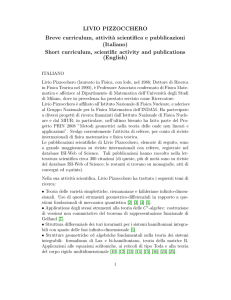
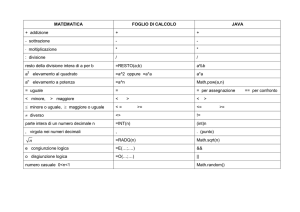
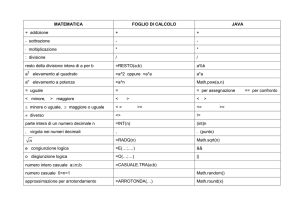
![2A MATH bollettino_04 [08-06-2015]](http://s1.studylibit.com/store/data/003952862_1-8a629a49aebbcb1f6f442503494f34ef-300x300.png)
